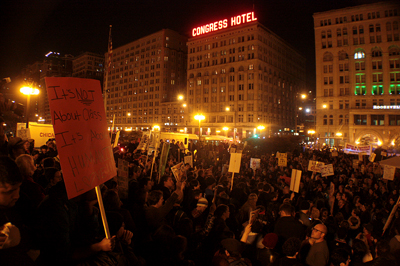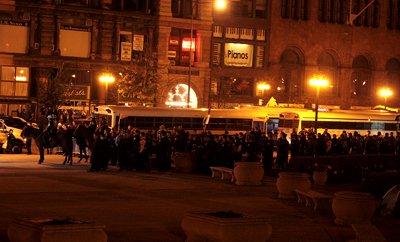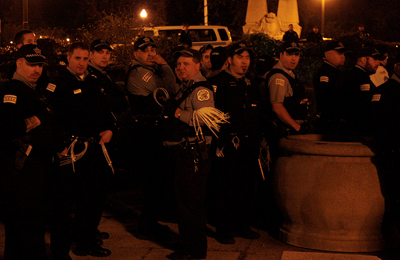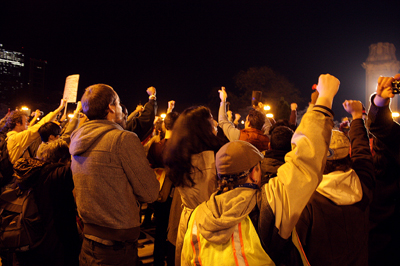St. Louis' amazing title run a fitting end to a captivating postseason
 Michael Heiman / Getty Images
Michael Heiman / Getty ImagesThe St. Louis Cardinals celebrate after defeating the Texas Rangers in Game 7. Of his team, manager Tony La Russa said "we have more talent than people think. But we have great guts.''
OPINION
By Tony DeMarco
NBCSports.com contributor
updated 3:08 a.m. ET Oct. 29, 2011
 | Tony DeMarco |
|
ST. LOUIS - About the time the St. Louis Cardinals fell 10 1/2 games out of first place in late-August, manager Tony La Russa paid a visit to commissioner Bud Selig during a series in Milwaukee.
Recalling that meeting before World Series Game 7, Selig said: "I congratulated him on his year, and he said, 'we're not done'. And he wasn't kidding. When you think back, a lot of things had to happen. It's been amazing.''
Then the Cardinals went out and finished one of the unlikeliest, unexpected World Series championships ? a fitting end to a captivating postseason.
The party at Busch Stadium started as soon as left fielder Allen Craig caught David Murphy's fly ball for the final out in a 6-2 victory over the Texas Rangers, and carried on for a couple hours. Next stop: A Sunday parade through downtown.
"I think it's the best moment of my career,'' first baseman Albert Pujols said amidst the celebration. "The way that we did it. The way that we got in (to the playoffs). The way that we won it. It's pretty special.''
So many memorable moments. So many storylines. So many different elements. But when you think about it, in a postseason including a record 38 games ? only three possible games weren't played in the seven postseason series ? and 13 one-run games, who else but the wild-card Cardinals, a team that didn't get in until the last day of the regular season, should win it all?
"It's hard to really imagine it actually happened,'' La Russa said.
Last things first: Your World Series MVP (and NLCS MVP, as well) is David Freese, and don't feel too badly if you didn't know much about him until now. The quickie bio:
St. Louis kid, quit the game for a while after high school, traded to the Cardinals organization as a minor-leaguer in 2007, endured a string of injuries that slowed his development, and in his third big-league regular season, hit .290 with only 10 home runs and 55 RBI in 97 games before all of this:
- Setting a new postseason RBI record with 21, and tying the hits (25) and doubles (8) records.
- Hitting five home runs and posting a .397 postseason average ? including .545 in the NLCS and .348 in the World Series.
- Joining five others who have won LCS and World Series MVPs in the same postseason.
If you told Freese a decade ago where' he'd be on Friday night, he says his response would have been, "no chance. This is why you keep battling. I had plenty of days in my life when I thought I wasn't close to being a big-leaguer.''
Freese's Game 6 heroics were legendary enough ? a two-out, two-strike, two-run triple that tied the game in the bottom of the ninth, and the walk-off blast over the center-field wall to win it in the 11th.
But he wasn't finished. In Game 7, his two-run double in the bottom of the first tied the game, and set the tone on a night when the Rangers couldn't get up after a final blow to the gut.
"This means everything,'' Freese said. "As I sit here now, I can't believe we did this.''
There's no questioning the role MLB played in postponing Game 6 by one night due to a forecast of rain. If the game had been played Wednesday, it would have been affected by cold, drizzly conditions ? although very possibly would have gone uninterrupted.
But there's also no denying the affect that decision had on this series, as it allowed ace Chris Carpenter to come back on three days' rest and become the first pitcher since Boston's Bruce Hurst in 1986 to start both a World Series Game 5 and Game 7.
And in a postseason filled with brilliant decision-making ? and one uncharacteristically memorable set of Game 5 gaffes ? La Russa may have saved his best choice for last. Except that he really didn't make the decision to start Carpenter. It was made for him after a conversation between Carpenter and pitching coach Dave Duncan.
"I called Dunc (Friday) morning, and said, 'let's lay out the options','' La Russa said. "And he said, "it's Carp', and he hung up on me."
Carpenter convinced Duncan that he was up to the task physically, and would make a pitch selection adjustment after learning from a failed start on three days' rest in NLDS Game 2 against Philadelphia (four earned runs in three innings).
"And the last part of it is what he means to our club,'' La Russa said. "I think our guys feel better about him starting than anybody else.''
And why not? Carpenter made his way through six-plus innings in Game 7, allowing only two first-inning runs, and won his fourth game of this postseason (4-0-3.25 ERA). Climbing the list of postseason pitching heroes, he is 9-3-3.05 in 15 career starts and 4-0-2.00 in four World Series starts.
"I didn't know how long they would let me go, so tried hard to get every out I could,'' Carpenter said. "Nobody said anything to me (about being lifted), and I felt stronger and my command got better as I went along.''
Just as the Cardinals did down the stretch. How did it all come together in such dominating fashion: 23-9 after Aug. 25 and 15-5 in their last 20 before upsetting the heavily favored Philadelphia Phillies, Milwaukee Brewers, and finally, rallying from a 3-2 deficit to beat the Rangers?
About the time they fell to that double-digit deficit, a close team came even closer, led by the veteran influences of Pujols, Carpenter, Lance Berkman and others.
"A few of us felt that something had to be said,'' Carpenter said. "I was, 'we need to start playing St. Louis Cardinals baseball.' It was about continuing to play hard and playing like we're capable of playing.''
Moves made around the trade deadline that brought Edwin Jackson, Octavio Dotel, Marc Rzepczynski, Arthur Rhodes (released by Texas, ironically) and Rafael Furcal not only filled talent gaps, but instilled a new sense of focus and purpose: Winning rings for veterans who hadn't won any.
"Mo (General manager John Mozeliak) asked us if we made some changes, would we have a chance to win?'' La Russa said. "And we said yes. So he went out and put his neck on the line, and made the changes.
"The first couple weeks with the better ball club, we weren't playing well, and we kind of avoided Mo for a while. But then we started showing that he had given us more weapons. And this is where we ended up.''
As the 11th Cardinals team to win a World Series, the fifth wild-card team to do so, and the 19th team to rally from a 3-2 deficit.
"We have more talent than people think,'' La Russa said. "But we have great guts.''
? 2011 NBC Sports.com? Reprints![]()
advertisement
More newsRams honor Series champs
Chris Carpenter, Tony La Russa and the World Series champion Cardinals are drawing huge cheers at the NFL game between the St. Louis Rams and New Orleans Saints.
Fan: No regrets about returning Game 6 homer ball
??As hordes of other St. Louis Cardinals fans turned out Sunday to swaddle themselves in their team's improbable World Series title, Dave Huyette was counting his blessings rather than the riches he might have received had greed overtaken sportsmanship.
Source: http://nbcsports.msnbc.com/id/45085918/ns/sports-baseball/
toy toy abacus abacus spongebob bot foot locker
 Pocket-lint |
Pocket-lint |  Monwindowsphone (translated) | Email this | Comments
Monwindowsphone (translated) | Email this | Comments 















